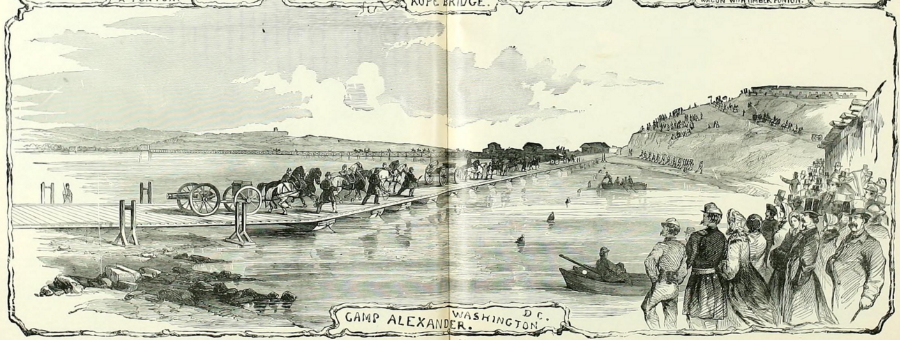 Creating a quick way across a river during wartime is a question that has plagued generals since the dawn of warfare. As early as 480 BC, clever engineers had come up with a quick solution: A bridge that was, in essence, a series of boats tied together. These pontoon bridges could be rigged up quickly, and then used to transport armies and material across an otherwise unfordable obstacle.
Creating a quick way across a river during wartime is a question that has plagued generals since the dawn of warfare. As early as 480 BC, clever engineers had come up with a quick solution: A bridge that was, in essence, a series of boats tied together. These pontoon bridges could be rigged up quickly, and then used to transport armies and material across an otherwise unfordable obstacle.
Unsurprisingly, this technology was used during the Civil War, most importantly by the New York 15th and 50th Engineer Regiments. The 15th had been organized by John McLeod Murphy (pic) starting in April, 1861. Originally an infantry regiment, it was converted to an engineers regiment in late October, after having served in northern Virginia. The regiment was ordered to Washington, where it reported to Lieutenant Colonel Alexander at Camp Alexander, near the Navy Yard.
On December 16, 1861, the National Republican reported on Murphy and his men’s latest achievement. The language is of the sort that it is worthy of lengthy quotation:
History tells us of the experiment made by Xerxes to chain the Hellespont with a bridge of boats over which to march his invading legions to the conquest of Greece. History also chronicles the signal failure of the enterprise projected by the proud leader of the Persian hosts. The idea of crossing rivers with bridges constructed by lashing boats together is therefore not original with the moderns, but originated in the brain of the royal invader of Attica, years before the Christian era. To modern times, however, belongs the credit of perfecting this important branch of military science, and great have been the improvements made within the past few years. Very successful experiments have been made during the last few days, under the direction of Colonel Murphy, of the New York Fifteenth, in throwing a pontoon bridge across the Eastern Branch of the Potomac, just above the navy yard. On Saturday, a bridge of three hundred and sixty feet in length was constructed in a few minutes, and submitted to severe practical tests, with entire success. It is very simple in construction.
The Evening Star that day was not quite as fulsome in their report on the project, but did mention that, among the tests, the bridge was crossed by “men, horses, and heavy wagons.” Furthermore, the Star reported that the engineers also constructed a “new flying bridge of ropes” with which a ravine 400 feet wide and 50 feet deep was crossed. The whole affair was witnessed by Commodore Joseph Smith, of the Bureau of Yards and Docks, and Mary Jane Welles, the wife of Secretary of the Navy Gideon Welles.

Picture from The Soldier in Our Civil War by Paul F. Mottelay and T. Campbell-Copeland, showing the Camp Alexander pontoon bridge. (Archive.org)
The New York 15th expertise was used repeatedly throughout the war, and there is even a monument to them (and the 50th) at Gettysburg; while the two units were not actually involved in the fighting, they did build a number of bridges across the Potomac River that allowed them to make it to Gettysburg. The 15th had, in fact, for the most part, been mustered out a few days prior to the great battle.
By then, they had frequent reason to show off the expertise that they had first exhibited near the Navy Yard in December 1861.
